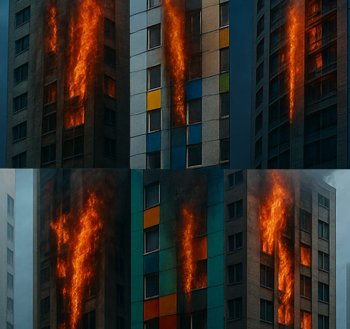Argon
Argon (Ar) is an inert gas of the noble gases (group 18). It is colourless, odourless and inert to other substances. It makes up 0.94% of the Earth’s atmosphere, the third most abundant atmospheric gas, with levels increasing gradually because radioactive potassium-40 turns into argon as it decays. Argon is 1.38 times heavier than air and can be obtained through the distillation of liquid air.
It has a number of uses but is well know as an infill gas for double glazed units, where because of its density it improves thermal performance. It is generally accepted that the argon will normally leak from the unit at a rate of 1% each year, or more if the seals degrade or break.
Other uses of argon include the production of titanium and other reactive elements as it creates an inert environment preventing oxidisation and potential corrosion. Fluorescent tubes and low-energy bulbs also make use of argon with an electric discharge passing through the gas, generating UV light, the bulbs coating on the inside is activated by UV light and glows brightly.
It was unwittingly isolated in the late 1700's and mistaken for unreactive air but wasn't fully discovered until the late 1800's when Lord Rayleigh and William Ramsay separated it from liquid air. Today Germany is the lead exporter of Argon, followed by Belgium, the Netherlands and China. The manufacture and use of argon creates minimal health risks, although an asphyxiant only in large volumes when it might become hazardous. The gas dissipates into the air under normal conditions and is not harmful to plant, animal or aquatic life.
[edit] Related articles on Designing Buildings
- Carbon monoxide requirement J3.
- Gas Safe.
- Health and Safety.
- BFRC window rating scheme.
- Conservation rooflights.
- Domestic windows.
- Double glazing.
- Double glazing v triple glazing.
- Extra-low voltage lamps.
- Illuminance.
- Glass.
- Glass mullion system.
- Glazier.
- Low-E glass.
- Lamp efficacy.
- Light fitting.
- Lighting and energy efficiency.
- Lighting energy numeric indicator LENI.
- Luminaire efficacy.
- Luminous flux.
- Power factor.
- R-value.
- Secondary glazing.
- Suction lifter.
- Triple glazing.
- Types of lighting.
- Types of lamp.
- Types of window.
- Window.
- Window frame.
Featured articles and news
Delivering for tenants; National Retrofit Hub
New report offers recommendations to strengthen energy efficiency standards to protect private renters.
Government consultations for the summer of 2025
A year of Labour, past and present consultations on the environment, the built environment, training and tax.
CMA competitiveness probe of major housing developers
100 million affordable housing contributions committed with further consultation published.
Homes England supports Greencore Homes
42 new build affordable sustainable homes in Oxfordshire.
Zero carbon social housing: unlocking brownfield potential
Seven ZEDpod strategies for brownfield housing success.
CIOB report; a blueprint for SDGs and the built environment
Pairing the Sustainable Development Goals with projects.
Types, tests, standards and fires relating to external cladding
Brief descriptions with an extensive list of fires for review.
Latest Build UK Building Safety Regime explainer published
Key elements in one short, now updated document.
UKGBC launch the UK Climate Resilience Roadmap
First guidance of its kind on direct climate impacts for the built environment and how it can adapt.
CLC Health, Safety and Wellbeing Strategy 2025
Launched by the Minister for Industry to look at fatalities on site, improving mental health and other issues.
One of the most impressive Victorian architects. Book review.
Common Assessment Standard now with building safety
New CAS update now includes mandatory building safety questions.
RTPI leader to become new CIOB Chief Executive Officer
Dr Victoria Hills MRTPI, FICE to take over after Caroline Gumble’s departure.
Social and affordable housing, a long term plan for delivery
The “Delivering a Decade of Renewal for Social and Affordable Housing” strategy sets out future path.
A change to adoptive architecture
Effects of global weather warming on architectural detailing, material choice and human interaction.
The proposed publicly owned and backed subsidiary of Homes England, to facilitate new homes.
How big is the problem and what can we do to mitigate the effects?
Overheating guidance and tools for building designers
A number of cool guides to help with the heat.
The UK's Modern Industrial Strategy: A 10 year plan
Previous consultation criticism, current key elements and general support with some persisting reservations.
Building Safety Regulator reforms
New roles, new staff and a new fast track service pave the way for a single construction regulator.

























